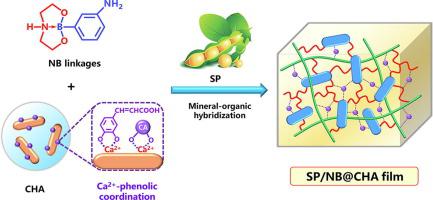当前位置:
X-MOL 学术
›
Chem. Eng. J.
›
论文详情
Our official English website, www.x-mol.net, welcomes your
feedback! (Note: you will need to create a separate account there.)
Bioinspired mineral–organic strategy for fabricating a high-strength, antibacterial, flame-retardant soy protein bioplastic via internal boron–nitrogen coordination
Chemical Engineering Journal ( IF 13.3 ) Pub Date : 2021-09-24 , DOI: 10.1016/j.cej.2021.132616 Kuang Li 1 , Shicun Jin 1 , Shuaicheng Jiang 1 , Xiaona Li 1 , Jiongjiong Li 1 , Sheldon Q. Shi 2 , Jianzhang Li 1, 3
Chemical Engineering Journal ( IF 13.3 ) Pub Date : 2021-09-24 , DOI: 10.1016/j.cej.2021.132616 Kuang Li 1 , Shicun Jin 1 , Shuaicheng Jiang 1 , Xiaona Li 1 , Jiongjiong Li 1 , Sheldon Q. Shi 2 , Jianzhang Li 1, 3
Affiliation

|
Plant-derived renewable and biodegradable bioplastics are attractive alternatives to petroleum-based materials, but their applicability is limited by insufficient interface bonding and the antibacterial properties of biopolymer. Inspired by the unique hierarchical structure of nacre, we report a facile and sustainable mineral–organic strategy that fabricates a soy protein (SP)-based film with excellent mechanical strength and toughness. The nitrogen-coordinating boronic diester (NB) is synthesized from boronic acid and diols, which form enhanced cross-linking networks through dynamic glue linkages. As a glue molecule, caffeic acid (CA) containing phenolic compounds can co-assemble with hydroxyapatite (HA) in the SP matrix to produce inorganic–organic CA-functionalized HA (CHA) hybrids. The strong affinity between the NB and CHA hybrids combined with dynamic covalent bonds and sacrificial hydrogen bonds substantially improves the bonding strength and cohesion of the SP-based composites. The tensile strength and toughness of the resultant film were 13.89 MPa and 14.72 MJ/m, respectively, 361% and 489% higher than the pristine SP film. Owing to the biomineralization and phenolic components, the incorporated NB@CHA hybrids endow the film with desirable water resistance, flame retardancy, UV protection performance, and antibacterial activity. This biomimetic strategy provides a novel and versatile fabrication route to high-performance SP-based bioplastics for engineering and biological applications.
中文翻译:

通过内部硼氮配位制造高强度、抗菌、阻燃大豆蛋白生物塑料的仿生矿物有机策略
植物来源的可再生和可生物降解的生物塑料是石油基材料的有吸引力的替代品,但其适用性因界面结合不足和生物聚合物的抗菌性能而受到限制。受珍珠层独特的分层结构的启发,我们报告了一种简便且可持续的矿物有机策略,可制造具有优异机械强度和韧性的基于大豆蛋白(SP)的薄膜。氮配位硼二酯(NB)由硼酸和二醇合成,通过动态胶键形成增强的交联网络。作为胶分子,含有酚类化合物的咖啡酸(CA)可以与 SP 基质中的羟基磷灰石(HA)共组装,产生无机-有机 CA 功能化 HA(CHA)杂化物。 NB和CHA杂化物之间的强亲和力与动态共价键和牺牲氢键相结合,大大提高了SP基复合材料的结合强度和内聚力。所得薄膜的拉伸强度和韧性分别为13.89 MPa和14.72 MJ/m,比原始SP薄膜高361%和489%。由于生物矿化和酚类成分,掺入的 NB@CHA 杂化物赋予薄膜良好的耐水性、阻燃性、紫外线防护性能和抗菌活性。这种仿生策略为工程和生物应用的高性能 SP 生物塑料提供了一种新颖且通用的制造途径。
更新日期:2021-09-24
中文翻译:

通过内部硼氮配位制造高强度、抗菌、阻燃大豆蛋白生物塑料的仿生矿物有机策略
植物来源的可再生和可生物降解的生物塑料是石油基材料的有吸引力的替代品,但其适用性因界面结合不足和生物聚合物的抗菌性能而受到限制。受珍珠层独特的分层结构的启发,我们报告了一种简便且可持续的矿物有机策略,可制造具有优异机械强度和韧性的基于大豆蛋白(SP)的薄膜。氮配位硼二酯(NB)由硼酸和二醇合成,通过动态胶键形成增强的交联网络。作为胶分子,含有酚类化合物的咖啡酸(CA)可以与 SP 基质中的羟基磷灰石(HA)共组装,产生无机-有机 CA 功能化 HA(CHA)杂化物。 NB和CHA杂化物之间的强亲和力与动态共价键和牺牲氢键相结合,大大提高了SP基复合材料的结合强度和内聚力。所得薄膜的拉伸强度和韧性分别为13.89 MPa和14.72 MJ/m,比原始SP薄膜高361%和489%。由于生物矿化和酚类成分,掺入的 NB@CHA 杂化物赋予薄膜良好的耐水性、阻燃性、紫外线防护性能和抗菌活性。这种仿生策略为工程和生物应用的高性能 SP 生物塑料提供了一种新颖且通用的制造途径。











































 京公网安备 11010802027423号
京公网安备 11010802027423号